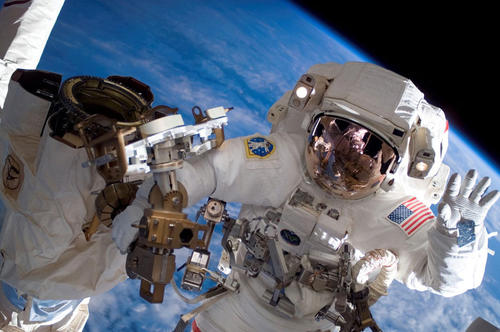How Space Lost Its Luster
Scholars at Freie Universität study why expeditions to the moon and Mars dimmed the allure of utopian visions of life in space
Feb 29, 2012
Work on the International Space Station: In 2007 the astronauts Clay Anderson (pictured) and Fyodor N. Yurchikhin installed a camera during more than seven hours in orbit.
Image Credit: NASA/courtesy of www.nasaimages. org
The popularization of thinking about space, a major fad centering on rockets and space exploration, reached an initial climax in the 1920s and 1930s. While writers and filmmakers were presenting their utopian visions of travel to the moon and distant planets to a broad public, scientists and engineers were hard at work on developing the rockets that would make space exploration a reality.
The line between fantastical visions in literature and film and what might actually be possible in the future was fluid. Even older than the vision of travel to the moon was the idea of a space station near Earth, a point of departure for voyages to explore and colonize the depths of space. “People realized early on that the crux of the problem was not traveling into space, but overcoming the Earth’s gravity,” says historian Alexander C. T. Geppert, who is studying the history of European notions of space and extraterrestrial life in the 20th century at Freie Universität Berlin.
At the time, people believed a space station in low-Earth orbit was necessary as a stopover site where spaceships could be assembled with less effort in zero gravity, allowing people to travel to the moon, Mars, or farther into space. For Geppert, who has headed an Emmy Noether junior research group since 2010, it is an irony of history that the International Space Station (ISS) brought a longstanding utopian vision to life at the end of the 20th century – but that the vision itself “no longer really captivates us.”
Why does the International Space Station – the most expensive civilian project in the history of space, currently orbiting about 380 kilometers above the Earth – have so little allure? The research group, based at the Friedrich Meinecke Institute, is examining how the dreams and hopes surrounding a future beyond the Earth have changed, both in real history and in fictional representations. The researchers see the period between 1957 and 1972 as a crucial one – the 15-year span during which the Soviet Union and the United States engaged in the “Space Race,” each nation trying to be the first to reach the moon. During this time, about 60 Soviet and American probes narrowly missed the moon, entered lunar orbit, and landed on it, sometimes softly and sometimes hard.
During the same period, Neil Armstrong and Edwin “Buzz” Aldrin, of the Apollo 11 crew, were the first people to land on the moon, followed by nine others. Travel to the Earth’s satellite, about 360,000 kilometers away, had been depicted in vivid detail in many films, starting with Fritz Lang’s final silent film, Woman in the Moon, which premiered in 1929. “Before the trip actually took place, in 1969, people had already seen pictures of it, more or less, several times,” says Daniel Brandau, a member of the research group. But people never took the next step: building a lunar colony, a development that had also already been anticipated in fiction.
After the Apollo program, the drive to explore space slackened, but did not halt entirely. From Soviet and American territory, a large number of probes were launched at our neighboring planet Mars in the 1970s. “It was a huge disappointment when we could not find the slightest evidence of life on the surface of Mars,” says William R. Macauley, who is studying the aesthetics of European space exploration within Geppert’s junior research group. Expeditions into space, with all the expectations associated with them, made the dream of life in space suddenly seem unrealistic.
“The public became more skeptical and stopped asking how we were to travel into space, but why we should do so in the first place,” Macauley says. Amid the oil crisis, with use of nuclear energy on the rise, a critical global consciousness emerged on both sides of the Atlantic. “The focus turned more and more to our own planet and conserving its resources, and life in space lost its luster,” Geppert says. It seems the magic only works as long as we haven’t been there.

